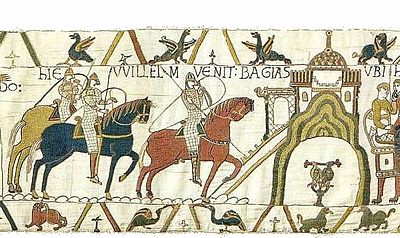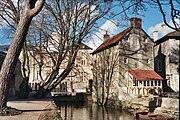Bayeux
Bayeux | |
|---|---|
Subprefecture and commune | |
 The historic centre, the Bayeux Cathedral, the Aure and tourist office | |
| Coordinates: 49°16′46″N 0°42′10″W / 49.2794°N 0.7028°W | |
| Country | France |
| Region | Normandy |
| Department | Calvados |
| Arrondissement | Bayeux |
| Canton | Bayeux |
| Intercommunality | Bayeux Intercom |
| Government | |
| • Mayor (2020–2026) | Patrick Gomont[1] |
| Area 1 | 7.11 km2 (2.75 sq mi) |
| Population (2021)[2] | 12,775 |
| • Density | 1,800/km2 (4,700/sq mi) |
| Time zone | UTC+01:00 (CET) |
| • Summer (DST) | UTC+02:00 (CEST) |
| INSEE/Postal code | 14047 /14400 |
| Elevation | 32–67 m (105–220 ft) |
| 1 French Land Register data, which excludes lakes, ponds, glaciers > 1 km2 (0.386 sq mi or 247 acres) and river estuaries. | |
Bayeux (French pronunciation: [bajø]) is a commune in the Calvados department in Normandy in northwestern France.
Bayeux is the home of the
Administration
Bayeux is a sub-prefecture of Calvados. It is the seat of the arrondissement of Bayeux and of the canton of Bayeux.
Geography
Bayeux is located 7 kilometres (4 miles) from the coast of the English Channel and 30 km (19 mi) north-west of
The river Aure flows through Bayeux, offering panoramic views from a number of locations. The Aure has a relatively high level of turbidity and the speed of its brownish water is moderate because of the slight slope of the watercourse, although where it is narrow in places like the centre of Bayeux, higher surface speeds are generated. In the centre of Bayeux near the Bayeux Tapestry Museum, pH levels were measured at 8.35 and the electrical conductivity of water was tested at 37 microsiemens per centimetre. Turbidity was measured at 13 centimetres by the Secchi disk method. At this point of reference, flows are generally of the order of 50 cubic feet per second (1.4 m3/s).[citation needed]
The Bajocian Age in the Jurassic Period of geological time takes its name from the Latinised name of the inhabitants of Bayeux (the Bajocassi).[citation needed]
Etymology
The city was known as Augustodurum in the Roman Empire. It means the durum (Celtic word duro- 'door', 'gate', Welsh dor, Breton dor 'door', 'gate') dedicated to Augustus, Roman Emperor. The Celtic word duron, Latinised as durum, was probably used to translate the Latin word forum (Compare Fréjus Forum Julii, dedicated to Julius (Caesar)).[3]
In the Late Empire it took the name of the Celtic tribe who lived here: the Bodiocassi, Latinized in Bajocassi,
History
Origins
Founded as a Gallo-Roman settlement in the 1st century BC under the name Augustodurum, Bayeux is the capital of the former territory of the
The town is mentioned by Ptolemy, writing in the reign of Antoninus Pius, under the name Noemagus Biducassium (for *Noviomagus Badiocassium 'New market of the Badiocassi') and remained so until the time of the Roman Empire. The main street was already the heart of the city. Two baths, under the Church of St. Lawrence and the post office in rue Laitière, and a sculpted head of the goddess Minerva have been found, attesting to the adoption of Roman culture. In 1990 a closer examination of huge blocks discovered in the cathedral in the 19th century indicated the presence of an old Roman building. Bayeux was built on a crossroads between Lisieux and Valognes, developing first on the west bank of the river. By the end of the 3rd century a walled enclosure surrounded the city and remained until it was removed in the 18th century. Its layout is still visible and can be followed today. The citadel of the city was located in the southwest corner, and the cathedral in the southeast. An important city in Normandy, Bayeux was part of the coastal defence of the Roman Empire against the pirates of the region, and a Roman legion was stationed there.
Middle Ages

The city was largely destroyed during the
The 11th century saw the creation of five villages beyond the walls to the northeast, evidence of its growth during
Post-medieval

The area around Bayeux is called the Bessin, which was the
The
Bayeux is also the home of a memorial to all journalists who have lost their lives while reporting. The memorial was designed by Samuel Craquelin, who is a French architect. The memorial lists the names of 1,889 journalists killed between 1944 and 2007. The memorial was established in conjunction with the organisation Reporters Without Borders and is located in Bayeux because of its historic liberation on 7 June 1944. It was inaugurated on 2 May 2007.[7]
Population
The inhabitants of Bayeux are called Bayeusains [bajøzɛ̃] or Bajocasses [baʒokas].[8]
|
| |||||||||||||||||||||||||||||||||||||||||||||||||||||||||||||||||||||||||||||||||||||||||||||||||||||||||||||||||||||
| ||||||||||||||||||||||||||||||||||||||||||||||||||||||||||||||||||||||||||||||||||||||||||||||||||||||||||||||||||||||
| Source: EHESS[9] and INSEE (1968-2017)[10] | ||||||||||||||||||||||||||||||||||||||||||||||||||||||||||||||||||||||||||||||||||||||||||||||||||||||||||||||||||||||
Sights

Bayeux is a major tourist attraction, best known to British and French visitors for the
The Jardin botanique de Bayeux is a local botanical garden dating from 1864.
Personalities
- Muriel Barbery (born 1965), writer
- Berengar II of Neustria (died 896 AD), Count of Bayeux
- Roger Bésus (1915–1994), sculptor and writer
- Frédéric Née (born 1975), footballer
- Alain Chartier (1392–1430), politician and poet
- Pierre Du Bosc (1623–1692), preacher
- Stade Malherbe de Caen
- Jean-Léonce Dupont (born 1955), senator and former mayor
- Arcisse de Caumont (1801–1873), archaeologist, founded the Societé des Antiquaires de Normandy
- François de Caumont (1768–1848), designer and painter
- Miss George (1787–1867), actress and mistress of Napoleon
- Georges Lenepveu (1857–1923), inventor and master glassmaker
- François Gérard (1770–1837), painter and member of Bayeux
- Jean Grémillon (1901–1959), film director
- Joachim Rupalley (1718–1780) painter
- Édouard Lair de Beauvais, (1790–1851), architect
- Alfred Lair de Beauvais (1820–1869), organist and composer
- Robert Lefèvre (1755–1830), painter
- Lionel Lemonchois (born 1960), navigator
- Léon Le Cieux (1821–1873), violinist
- Damien Letulle (born 1973), Olympic archer
- Gabriel-Narcisse Rupalley (1745–1798), painter
- scrofula
- Éric Navet (born 1959), jockey
- Poppa of Bayeux, wife of Rollo
- Saint Vigor (died 537 AD), bishop of Bayeux from 513 to 537, destroyed a pagan temple in Bayeux
- William the Conqueror (1028-1087), Duke of Normandy, King of England
- Exuperius, (end of 4th century– died c. 410) Archbishop of Toulouse.
- Alfred-Georges Regner (1902–1987), painter-engraver
International relations
Bayeux is
See also
- Communes of the Calvados department
- Bayeux, Brazil
- Liberation of France
- Roman Catholic Diocese of Bayeux
References
- ^ "Répertoire national des élus: les maires". data.gouv.fr, Plateforme ouverte des données publiques françaises (in French). 2 December 2020.
- ^ "Populations légales 2021". The National Institute of Statistics and Economic Studies. 28 December 2023.
- ^ fr:Pierre-Yves Lambert, La langue gauloise, éditions errance 1994.
- ^ Xavier Delamarre, Dictionnaire de la langue Gauloise, éditions errance 2003.
- ^ Laeti Suevorum, noted in Jean Roemer, Origins of the English People and the English Language, p. 207 note 2.
- ^ Benoît, Chronique: "Mais a Baiues en a tanz/ Qui ne sevent si daneis non."
- ^ "The French town of Bayeux and Reporters Without Borders inaugurate a journalists memorial on the eve of World Freedom Day". Reporters Without Borders. 3 May 2007. Archived from the original on 9 January 2014. Retrieved 10 February 2013.
- ^ Calvados, habitants.fr
- ^ Des villages de Cassini aux communes d'aujourd'hui: Commune data sheet Bayeux, EHESS (in French).
- ^ Population en historique depuis 1968, INSEE
- ^ World Book Encyclopedia, p. 177, World Book Inc.
- ^ Cathedral of Bayeux: France Tourism Summaries
- ^ "Les villes jumelles". bayeux.fr (in French). Bayeux. Retrieved 21 November 2019.
External links
- Official Web site
- Tourist office Web site
- Minosh Photography
- Satellite photo on Google Maps
- British War Cemetery
- Pictures
-
Near the Centre Guillaume le Conquérant
-
Streets of Bayeux
-
Main entrance toBayeux War Cemetery
-
The Cross of Sacrifice in cemetery
-
Liberation memorial plaque in Bayeux









